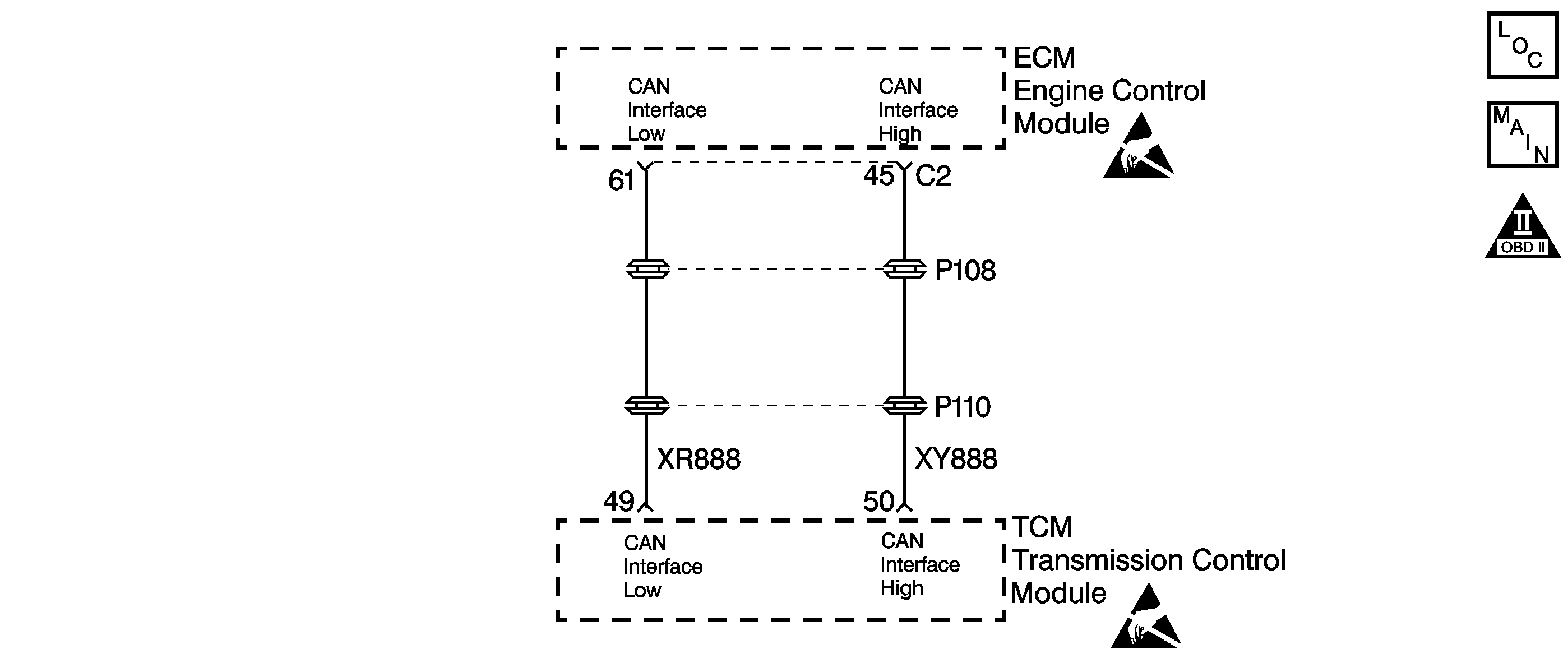
Circuit Description
The transmission control module (TCM) sends a signal to the engine control module (ECM) requesting reduced engine torque during shift events in order to improve shift feel. The ECM reduces engine torque by retarding the spark timing in response to the TCM request.
This TCM request (signal) is sent to the ECM through a communication network called controller area network (CAN). Circuits XR888 and XY888 are used to communicate CAN data between the ECM and TCM.
When the TCM detects the request for torque reduction has failed, then DTC P1740 will set. DTC P1740 is a type C DTC.
Condition for Running the DTC
The ignition switch is in the RUN position.
Condition for Setting the DTC
Request for engine torque reduction has failed.
Action Taken When the DTC Sets
| • | Early production - The TCM illuminates the service transmission lamp (STL). |
| • | Late production - The TCM flashes the Sport Mode Lamp. |
| • | The ECM records the operating conditions in the failure records at the time of the request from the TCM. |
| • | The TCM memory stores the DTC at the time of the first failure. |
| • | The TCM will command maximum line pressure. |
| • | The TCM will freeze shift adapts. |
| • | The TCM will inhibit torque control. |
Conditions for Clearing the STL/DTC
| • | Early production - The TCM turns off the STL as soon as the fault is no longer present. |
| • | Late production - The TCM stops flashing the sport mode lamp as soon as the fault is no longer present. |
| • | A history DTC clears after forty consecutive warm-up cycles, if no failures are present by this diagnostic or any other emission related diagnostic. |
| • | The scan tool clears the DTC. |
| • | The TCM cancels the DTC default mode actions when the fault no longer exists and the ignition switch is OFF long enough in order to power down the TCM. |
Diagnostic Aids
Vehicles equipped with Fuel Cap Lamps utilize the Sport Mode lamp to indicate a transmission malfunction. In these vehicles, the Sport Mode Lamp flashes at 200 millisecond intervals when the TCM commands the lamp ON.
Vehicles not equipped with Fuel Cap Lamps are equipped with a dedicated Service Transmission Lamp (STL) on the Instrument Panel Cluster (IPC). The STL illuminates steadily when the TCM commands the lamp ON.
Drive the vehicle and watch the request for torque reduction to be present when shift events occur.
Test Description
The numbers below refer to the step numbers on the diagnostic table.
-
This step verifies the request for torque reduction in present.
-
This step checks for engine DTCs that would normally set if engine torque conditions were detected.
DTC P1740 Torque Reduction Signal Circuit
Step | Action | Value(s) | Yes | No |
|---|---|---|---|---|
1 | Was the Powertrain On-Board Diagnostic (OBD) System Check performed? | -- | ||
Important: Before clearing the DTC, use the Scan Tool in order to record the Failure Records. Using the Clear Info function erases the Failure Records from the ECM/TCM. Does the TCM torque reduction required display NO? | -- | Go to Diagnostic Aids | ||
3 | Does the TCM torque reduction required display YES? | -- | -- | |
4 | Does the engine torque display a high torque value with transmission in D4 and the engine idling? | -- | -- | |
Check for any ECM DTCs. Are there ECM DTCs present? | -- | -- | ||
6 | Go to the appropriate ECM DTC. Make the necessary repairs. Refer to Engine Controls. Are the DTC repairs complete? | -- | Go to Engine Controls | |
7 | Perform the following procedure in order to verify the repair:
Does the Scan Tool TCM torque reduction required display NO and is DTC P1740 not present? | -- | System OK |
